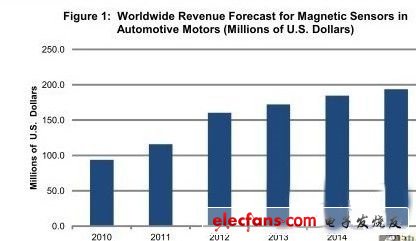The latest forecast is that the application rate of silicon magnetic sensors in automotive motors will increase rapidly. Due to the improvement of automobile safety, convenience and fuel efficiency, the application of silicon magnetic sensors in automobile motors will grow rapidly, and sales in this market will grow by nearly 40% in 2012. In 2012, the sales of magnetic sensors in the automotive motor field will reach 160.3 million US dollars, a 38.2% increase from this year's 116 million US dollars, continuing the steady growth momentum of the past three years. Although the growth rate of sales will slow down to single digits after 2012, the compound annual growth rate for 2010-2015 will still reach 16%. By 2015, the sales of magnetic sensors in the automotive motor field will rise to 193.6 million US dollars, as shown in the figure.

Magnetic sensors are widely used in various motors in industrial automation processes, especially in the automotive industry, accounting for 50% of their market value. For example, there are more than 10 types of motors in low- and mid-range cars, such as fan cooling, alternators, and windshield wipers. The limousine has nearly 100 motors, including sensors for air conditioning blowers, electronic steering and throttle control, and transmission sensors for automation and new dual-clutch systems; and seat position adjustment, sunroof, tachometer, and headlights Sensors for position adjustments and pillows are even used to control intake dampers based on air quality information.
An important factor that drives people to improve motor efficiency is energy consumption. Saving every drop of fuel is critical, and every gram of carbon dioxide produced must be taken into account. The trend in this regard is the electrification of belt-driven motors and the replacement of brushless DC motors. These more efficient motors allow major power transmission components such as water-cooled pumps, oil pumps, and other auxiliary pumps to be operated on demand, and can reduce overall energy requirements.
Another application of magnetic sensors in motors is shaft position coding-for example, in power windows, the sensor can determine how many turns the shaft has to control the travel of the window regulator. The sensor can also detect the abnormal load caused by the human hand, and provides the so-called "anti-pinch" function. When the object is hit, the motor can be reversed.
Electric power steering is also a fast-growing DC motor application, used to replace electro-hydraulic systems, which use pumps to generate pressure to improve fuel efficiency. The sensor is used for motor commutation and current detection.
In hybrid electric vehicles, magnetic sensors are used to monitor auxiliary motor inverters. The inverter is used to convert the DC power of the battery into the AC power of the motor. This conversion requires the use of three current sensors, one for each phase of the motor.
Advanced automotive applications require Hall IC and AMR sensors
Generally, automotive motors use Hall ICs and are used for commutation in three-phase motors. Three-phase motors usually have six states and are measured by three digital Hall ICs to achieve closed-loop regulation. In some cases, a magnetic sensor may not be needed, and the Hall IC may be replaced by a simple current measurement method in the circuit. For example, a DC motor operating at a constant speed and no load change environment (such as a fan transported at a constant speed) can infer the required speed information without using sensors.
However, for advanced motors that need to understand load changes and torque information, Hall ICs and some anisotropic magnetoresistive (AMR) sensors are needed to measure the motor's position on the shaft.
In particular, the usage of AMR will increase in the next five years. The biggest application will be the tachometer motor in the speed and speed meter, which can make the motor quiet.
SK6812 Digital LED Strip is one of single signal transmission full color led strip.
SK6812 is an intelligent internal control LED light source and each component is a pixel point.
Have same functions and same PCB With WS2812B, but difference is the SK6812IC can be inside and outside,Working Voltage is 5-24VDC. The Sk6812IC can be replace the WS2812B in some cases.
SK6812 Digital LED Strip
RGB CCT LED Strip,SK6812 LED Strip,SK6812 Digital LED Strip,Mini RGB LED Strip
SHEN ZHEN SEL LIGHTING CO.,LTD , https://www.sel-lighting.com